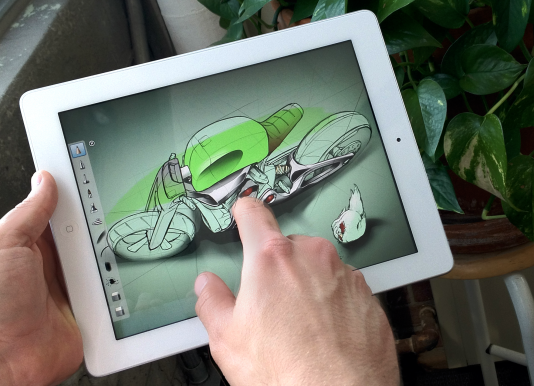Apple gives little or no advanced notice when they change specs; Google is not much more forthcoming about changes to Android. Even a 1000-lb. gorilla like Autodesk has to find a way to stay agile.
When Apple introduced Retina Display on the iPad in March of this year, only a few of the thousands of apps developers who write software for the iPad were given advance notice. Graphics powerhouse Autodesk, which has embraced mobile platforms more enthusiastically than any other CAD vendor, was more fortunate; they were given two weeks to prepare. But the heads-up was only because Apple wanted to use SketchBook as one of the featured apps in the product unveiling.

Chris Cheung is a product line manager at Autodesk who came to the company several years ago with the Alias acquisition. Sketchbook— featured on-stage when Apple introduced Retina Display technology—is part of his responsibility. In this interview, Cheung describes the new development environment software vendors face in the mobile market; having to adjust quickly to a new graphics standard is only one of the challenges Autodesk faced as an apps developer.
GraphicSpeak (GS): Autodesk was one of the first out the door with apps to support Retina Display. How did you get to be on-stage Day One for the Retina Display release?
Chris Cheung (CC): Let me give you a bit of history, because Sketchbook is a good case study for the process. We were in the original meeting of Apple and software developers for the first iPad. They told everyone in the meeting “You have 60 days to make apps for this new device” which we now know was the iPad. We didn’t know they were going to launch Retina Display until it was down to the wire and we had a chance to present on March 7.
GS: How does Autodesk cope with this kind of pressure?
CC: Sometimes we watch such presentations like the Retina Display announcement right along with consumers. We now have to keep our ears to the ground and be flexible. It is very different from the days when a vendor would gather partners in advance. In the past, we had road maps and definite release dates and targets. Now we must be reactive to new things on both Android and iOS. They don’t happen on our timeline, but theirs. We must listen for rumor, even though it is dangerous.
GS: Retina Display was not an incremental improvement in graphics; it was more like a quantum leap. What did Retina Display mean to Autodesk?
CC: Retina Display is interesting to us. It is much more than a feature or a requirement. For me, when I first saw it live, my first impression was that it was just a sharper image. But it didn’t take long for the wow factor to set in. It reminds me of the first day with HD vs. standard definition television.

Such graphic density has a massive but subtle impact on the user. For Autodesk, it sets a visual bar. For Sketchbook Ink we had to re-do the icons and the user interface. We couldn’t do just a UI size increase. The base screen showed so many pixels, we had to offer a canvas to match. Now we offer the larger canvas as a default; our free Sketchbook Express has it, too. People expect to do the bigger stuff, even on a lower-resolution device.
SketchBook is raster technology; a pixel-based app. Retina Display has a big impact because it gives us a larger canvas size. A 4X jump is a big deal. It was not that hard, but did require some work. Apple loaded the GPU to support the screen and increased the memory to make the resources available.
On the vector graphics side, resolution independent systems become just awesome. There is new stuff coming for AutoCAD WS and other products.
GS: Has Autodesk found its footing in this new developer landscape?
CC: Because we have been into mobile app development for a while, we are in a groove now. We have found a rhythm. It would be different if we were breaking into mobile development for the first time. We are sensitive to the environment. But we also have to prioritize. Is iCloud important? We had to think about it. When Retina Display was first shown to us, it was a no brainer for Autodesk—can you imagine how would people have reacted if Sketchbook did not support it?
Beyond supporting Retina Display, we must support the evolution of how people use these devices to create art—and in the digital arts, size matters. We were able to support Retina Display relatively quickly, and we updated AutoCAD WS and other our iOS apps quickly. Our response time speaks to how Autodesk has embraced mobile devices.
Responding to Retina Display helped us to collaborate internally and move quickly. Now it is a mindset we embrace, and I think we thrive off it. We now have a non-traditional pace; the pipeline is different.






